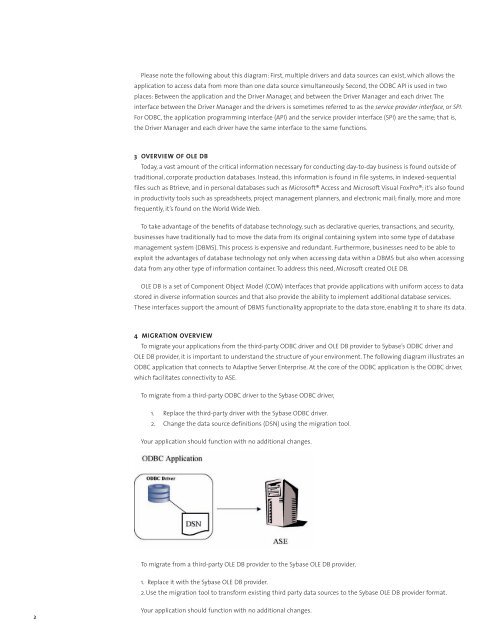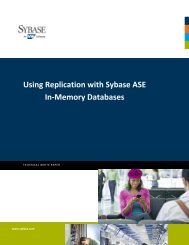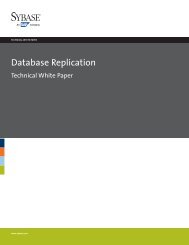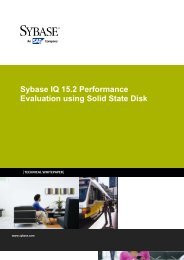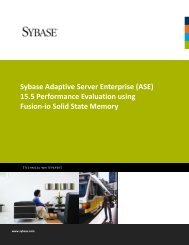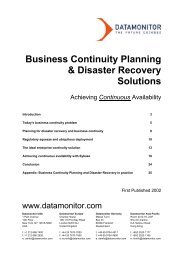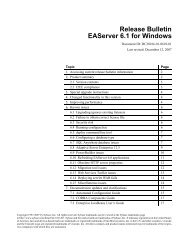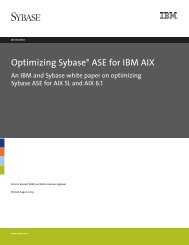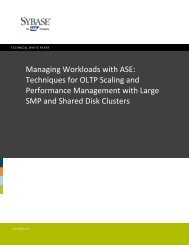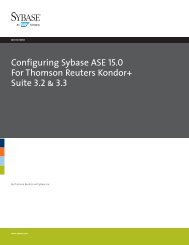ASE ODBC Driver and OLE DB Provider Migration Technical - Sybase
ASE ODBC Driver and OLE DB Provider Migration Technical - Sybase
ASE ODBC Driver and OLE DB Provider Migration Technical - Sybase
You also want an ePaper? Increase the reach of your titles
YUMPU automatically turns print PDFs into web optimized ePapers that Google loves.
2<br />
Please note the following about this diagram: First, multiple drivers <strong>and</strong> data sources can exist, which allows the<br />
application to access data from more than one data source simultaneously. Second, the <strong>O<strong>DB</strong>C</strong> API is used in two<br />
places: Between the application <strong>and</strong> the <strong>Driver</strong> Manager, <strong>and</strong> between the <strong>Driver</strong> Manager <strong>and</strong> each driver. The<br />
interface between the <strong>Driver</strong> Manager <strong>and</strong> the drivers is sometimes referred to as the service provider interface, or SPI.<br />
For <strong>O<strong>DB</strong>C</strong>, the application programming interface (API) <strong>and</strong> the service provider interface (SPI) are the same; that is,<br />
the <strong>Driver</strong> Manager <strong>and</strong> each driver have the same interface to the same functions.<br />
3 OveRview Of OLe dB<br />
Today, a vast amount of the critical information necessary for conducting day-to-day business is found outside of<br />
traditional, corporate production databases. Instead, this information is found in file systems, in indexed-sequential<br />
files such as Btrieve, <strong>and</strong> in personal databases such as Microsoft® Access <strong>and</strong> Microsoft Visual FoxPro®; it’s also found<br />
in productivity tools such as spreadsheets, project management planners, <strong>and</strong> electronic mail; finally, more <strong>and</strong> more<br />
frequently, it’s found on the World Wide Web.<br />
To take advantage of the benefits of database technology, such as declarative queries, transactions, <strong>and</strong> security,<br />
businesses have traditionally had to move the data from its original containing system into some type of database<br />
management system (<strong>DB</strong>MS). This process is expensive <strong>and</strong> redundant. Furthermore, businesses need to be able to<br />
exploit the advantages of database technology not only when accessing data within a <strong>DB</strong>MS but also when accessing<br />
data from any other type of information container. To address this need, Microsoft created <strong>OLE</strong> <strong>DB</strong>.<br />
<strong>OLE</strong> <strong>DB</strong> is a set of Component Object Model (COM) interfaces that provide applications with uniform access to data<br />
stored in diverse information sources <strong>and</strong> that also provide the ability to implement additional database services.<br />
These interfaces support the amount of <strong>DB</strong>MS functionality appropriate to the data store, enabling it to share its data.<br />
4 MigRatiOn OveRview<br />
To migrate your applications from the third-party <strong>O<strong>DB</strong>C</strong> driver <strong>and</strong> <strong>OLE</strong> <strong>DB</strong> provider to <strong>Sybase</strong>’s <strong>O<strong>DB</strong>C</strong> driver <strong>and</strong><br />
<strong>OLE</strong> <strong>DB</strong> provider, it is important to underst<strong>and</strong> the structure of your environment. The following diagram illustrates an<br />
<strong>O<strong>DB</strong>C</strong> application that connects to Adaptive Server Enterprise. At the core of the <strong>O<strong>DB</strong>C</strong> application is the <strong>O<strong>DB</strong>C</strong> driver,<br />
which facilitates connectivity to <strong>ASE</strong>.<br />
To migrate from a third-party <strong>O<strong>DB</strong>C</strong> driver to the <strong>Sybase</strong> <strong>O<strong>DB</strong>C</strong> driver,<br />
1. Replace the third-party driver with the <strong>Sybase</strong> <strong>O<strong>DB</strong>C</strong> driver.<br />
2. Change the data source definitions (DSN) using the migration tool.<br />
Your application should function with no additional changes.<br />
To migrate from a third-party <strong>OLE</strong> <strong>DB</strong> provider to the <strong>Sybase</strong> <strong>OLE</strong> <strong>DB</strong> provider,<br />
1. Replace it with the <strong>Sybase</strong> <strong>OLE</strong> <strong>DB</strong> provider.<br />
2. Use the migration tool to transform existing third party data sources to the <strong>Sybase</strong> <strong>OLE</strong> <strong>DB</strong> provider format.<br />
Your application should function with no additional changes.


